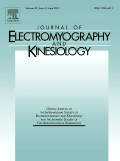
JOURNAL OF ELECTROMYOGRAPHY AND KINESIOLOGY
Scope & Guideline
Connecting Electromyography and Kinesiology for Health Innovations
Introduction
Aims and Scopes
- Electromyography (EMG) Research:
The journal extensively publishes studies utilizing electromyography for assessing muscle activity, including surface EMG and intramuscular techniques, to explore neuromuscular function in health and disease. - Biomechanics and Movement Analysis:
Research related to biomechanics, including kinematic and kinetic analyses of human movement, is a core focus, enabling insights into movement efficiency, injury mechanisms, and rehabilitation strategies. - Clinical Applications and Rehabilitation:
The journal addresses clinical applications of muscle function studies, especially in rehabilitation contexts, examining interventions for various musculoskeletal and neurological conditions. - Innovative Methodologies:
There is a consistent emphasis on developing and validating new methodologies for assessing muscle function, including novel imaging techniques and computational models, which contribute significantly to the field. - Motor Control and Coordination:
Studies exploring motor control, coordination, and the neural mechanisms underlying movement patterns are frequently featured, highlighting their relevance in both athletic performance and rehabilitation.
Trending and Emerging
- Integration of Technology in Movement Analysis:
There is a rising trend in utilizing advanced technologies such as wearable sensors, machine learning, and ultrafast imaging techniques to enhance the analysis of muscle function and movement patterns. - Focus on Chronic Pain and Rehabilitation:
An increasing number of studies are addressing chronic pain conditions, particularly related to low back pain, emphasizing rehabilitation strategies and the role of muscle activation in pain management. - Motor Control in Clinical Populations:
Research examining motor control dynamics, particularly in clinical populations such as those with stroke or ACL injuries, is gaining traction, highlighting the complexities of rehabilitation. - Neurophysiological Mechanisms of Muscle Activation:
There is a growing interest in exploring the neurophysiological underpinnings of muscle activation and coordination, which could lead to improved therapeutic interventions. - Multimodal Approaches to Muscle Function:
Emerging studies are increasingly adopting multimodal approaches that combine EMG with other measurement techniques (e.g., imaging, biomechanics) to provide a more holistic understanding of muscle function.
Declining or Waning
- Traditional Electromyography Techniques:
There seems to be a reduction in studies solely relying on traditional EMG techniques without integrating advanced methodologies such as high-density EMG or neuromuscular modeling. - Isolated Muscle Studies:
Research focusing exclusively on isolated muscle groups without considering the broader context of movement patterns and functional tasks appears to be decreasing. - Static Posture Assessments:
The emphasis on static posture assessments as standalone studies is waning, with a shift towards dynamic and functional movement analyses that provide more comprehensive insights. - Basic Biomechanics of Non-Clinical Populations:
The exploration of basic biomechanics in non-clinical populations is less frequent, as the journal increasingly prioritizes studies with clinical relevance or applications to rehabilitation. - Single-Condition Studies:
There is a noticeable decline in papers addressing single conditions or injuries, suggesting a trend towards more integrative and comparative studies across various populations.
Similar Journals

Kinesiology
Empowering professionals with cutting-edge insights.Kinesiology is a leading academic journal published by UNIV ZAGREB, FAC KINESIOLOGY in Croatia, dedicated to advancing the fields of physical therapy, sports therapy, rehabilitation, and sports science. With an ISSN of 1331-1441 and E-ISSN of 1848-638X, this open-access journal, established in 2004, provides a platform for innovative research and practical applications, allowing wider accessibility and dissemination of knowledge. The journal holds a strong position in the academic community, boasting a 2023 categorization of Q2 in Physical Therapy, Sports Therapy and Rehabilitation, and Q3 in Sports Science, reflecting its significant impact and relevance within these fields. Researchers, professionals, and students benefit from its rigorous peer-reviewed articles that address contemporary challenges and breakthroughs. The dynamic scope of the journal spans from 2008 to 2024, ensuring the incorporation of cutting-edge studies while fostering a vibrant exchange of ideas amongst scholars. As an invaluable resource, Kinesiology connects a diverse audience, promoting the growth of knowledge in health professions and enhancing evidence-based practices in physical therapy and rehabilitation.

EXPERIMENTAL BRAIN RESEARCH
Bridging Theory and Experimentation in Brain ScienceEXPERIMENTAL BRAIN RESEARCH is a renowned journal published by SPRINGER, dedicated to advancing understanding in the field of neuroscience. With a history dating back to 1966, this journal offers valuable insights into the mechanisms of brain function and neurological disorders, making it a vital resource for researchers, professionals, and students alike. While it currently holds a Q3 classification in the field of Neuroscience (miscellaneous) and ranks #73 out of 113 in Scopus's General Neuroscience category, it continually contributes to fostering innovative research and collaborative dialogue. The journal is not open access, ensuring that although content is subscription-based, it maintains a high standard of peer review and scholarly rigor. By covering a breadth of topics relevant to both experimental and theoretical aspects of brain research, EXPERIMENTAL BRAIN RESEARCH serves as an essential platform for disseminating cutting-edge discoveries and theories in the dynamic realm of neuroscience.

JOURNAL OF MOTOR BEHAVIOR
Unraveling the Science Behind Motor BehaviorJOURNAL OF MOTOR BEHAVIOR, published by Routledge Journals, Taylor & Francis Ltd, is a leading platform that explores critical insights into the dynamics of motor functions and behavior across various disciplines including biophysics, cognitive neuroscience, and sports science. With an ISSN of 0022-2895 and an E-ISSN of 1940-1027, this journal has been a vital resource since its inception in 1969, offering a comprehensive analysis of motor control, skill acquisition, and the neural mechanisms underlying motor performance. Positioned in the Q3 quartile across multiple categories for 2023, it ranks competitively within its fields, such as #136 in Orthopedics & Sports Medicine and #95 in Experimental & Cognitive Psychology. JOURNAL OF MOTOR BEHAVIOR serves not only as an essential reference for researchers and professionals but also as an invaluable resource for students pursuing studies in motor behavior and related areas, reflecting the ongoing evolution and significance of this field in enhancing our understanding of human movement and performance.

MEDICAL PROBLEMS OF PERFORMING ARTISTS
Advancing interdisciplinary insights for artistic well-being.MEDICAL PROBLEMS OF PERFORMING ARTISTS is a leading journal published by SCIENCE & MEDICINE INC, dedicated to exploring the unique health issues faced by performing artists, including musicians, dancers, and actors. With a history dating back to 1986, this journal provides a vital platform for interdisciplinary research and discussions that intersect the fields of medicine, performing arts, and history and philosophy of science. Recognized in the Q2 category for History and Philosophy of Science and Q3 in Medicine (miscellaneous), it maintains a robust standing with Scopus rankings placing it in the top 78th percentile in its categories. Although not open access, the journal ensures that high-quality research is disseminated effectively, contributing to the better understanding of the medical complexities surrounding artistic performance. Researchers, educators, and practitioners will find this journal invaluable for advancing knowledge and practices that support the health and well-being of performing artists.

SOMATOSENSORY AND MOTOR RESEARCH
Advancing Understanding in Sensory and Motor DynamicsSOMATOSENSORY AND MOTOR RESEARCH is a distinguished journal dedicated to exploring the intricate relationship between sensory and motor systems. Published by Taylor & Francis Ltd, this journal has been a significant resource for researchers in the fields of neuroscience and physiology since its inception in 1983, until it converged its coverage in 2017. Although it is no longer indexed in Scopus, SOMATOSENSORY AND MOTOR RESEARCH continues to contribute valuable insights into sensory systems and physiology, evidenced by its rankings in the lower percentiles of its respective categories. With a strong focus on empirical research, the journal aims to facilitate the dissemination of innovative studies that impact both academic understanding and clinical practices. Potential authors and researchers can access the journal's collection of past articles to further their knowledge and foster collaboration in this niche yet vital area of study. Its legacy endures as an informative platform for academics looking to bridge the gap between theoretical and applied sciences in the realm of somatosensory and motor functions.

International Journal of Sports Physical Therapy
Leading the way in sports therapy advancements.Welcome to the International Journal of Sports Physical Therapy, a premier platform dedicated to advancing the field of sports therapy and rehabilitation. Published by the NORTH AMER SPORTS MEDICINE INST-NASMI, this open access journal has been vital in disseminating state-of-the-art research since its inception in 2011. With an ISSN of 2159-2896, it boasts a commendable standing within the academic community, achieving a Q2 ranking in 2023 across multiple categories, including Orthopedics and Sports Medicine, Physical Therapy, and Rehabilitation. Spanning diverse topics relevant to sports physical therapy, this journal serves as an invaluable resource for researchers, clinicians, and students alike, promoting best practices and innovative techniques in the field. By maintaining a commitment to high-quality peer-reviewed content, it not only contributes significantly to the existing body of knowledge but also fosters collaboration among professionals seeking to enhance patient care and rehabilitation outcomes.

MUSCLE & NERVE
Pioneering Insights in Muscle and Nerve DynamicsMUSCLE & NERVE is a prestigious journal dedicated to the exploration and advancement of knowledge in the fields of neurology, cellular and molecular neuroscience, and physiology. Published by Wiley, this journal has been a crucial resource for researchers and practitioners since its inception in 1978, with an impressive convergence of studies anticipated through 2024. With an Impact Factor reflecting its relevance and influence—ranking in the Q2 and Q3 quartiles across multiple categories, including clinical neurology and medical physiology—MUSCLE & NERVE offers a rigorous peer-reviewed platform for groundbreaking research. It holds a respected position in Scopus rankings, illustrating its commitment to excellence and innovation in medicine and neuroscience. As a non-open access journal, it provides valuable resources for professionals seeking to further their understanding of neuromuscular physiology and related disciplines. The journal aims to foster dialogue and disseminate knowledge that advances the field, making it an indispensable tool for academics and clinicians alike.

Biomedical Human Kinetics
Unveiling Insights in Orthopedics and Sports MedicineBiomedical Human Kinetics, an esteemed academic journal published by SCIENDO, focuses on the intricate intersections of human movement, rehabilitation, and the study of physical therapies. Since its transition to an open access model in 2009, this journal has become a vital platform for sharing groundbreaking research and innovative methodologies in the fields of Orthopedics, Sports Medicine, and Physical Therapy. With an ISSN of 0043-9630 and an E-ISSN of 2080-2234, it operates out of Poland, providing global access to high-quality research. The journal’s standing in 2023 is notable, ranking in the Q3 category for both Orthopedics and Sports Medicine and Physical Therapy, Sports Therapy, and Rehabilitation, reflecting its commitment to fostering academic discourse within these important and evolving domains. Furthermore, with Scopus rankings placing it in the 36th percentile in its categories, Biomedical Human Kinetics is recognized for its contributions to the academic community. As it converges research efforts from 2016 to 2024, this journal serves as a cornerstone for researchers, professionals, and students dedicated to enhancing human health and performance through informed scientific exploration.

KLINISCHE NEUROPHYSIOLOGIE
Pioneering novel approaches in clinical neurophysiology.KLINISCHE NEUROPHYSIOLOGIE is a pivotal journal dedicated to advancing the field of clinical neurophysiology, published by GEORG THIEME VERLAG KG in Germany. With an ISSN of 1434-0275 and an E-ISSN of 1439-4081, this journal aims to disseminate high-quality research findings that enhance our understanding of neurological disorders and their physiological underpinnings. Although currently positioned in the fourth quartile in both Neurology (clinical) and Physiology (medical) categories, the journal offers a unique platform for novel insights and empirical studies, filling a crucial niche within the medical community. Researchers, healthcare professionals, and students can benefit from its Open Access option, which promotes wider accessibility and engagement with cutting-edge scientific discourse. As the journal converges through the years from 1998 to 2024, it remains committed to fostering scholarly collaboration and innovation in neurophysiological research, crucial for improving clinical outcomes.

Neuron
Pioneering insights into the nervous system's mysteries.Neuron is a premier journal in the field of neuroscience, published by CELL PRESS in the United States. Since its inception in 1988, this esteemed publication has been at the forefront of neuroscientific research and continues to shape our understanding of the brain and nervous system. With an impressive 2023 Scopus rank of #5 out of 113 in General Neuroscience and a notable Q1 quartile classification, Neuron is recognized for its high-quality, impactful contributions to both established and emerging areas of neuroscience. The journal does not operate under an open access model, yet it offers unparalleled insights and rigorous peer-reviewed research that are essential for researchers, professionals, and students alike. By publishing cutting-edge findings and fostering critical discussions, Neuron plays a vital role in advancing our collective knowledge in this constantly evolving field, making it an indispensable resource for anyone aiming to stay ahead in neuroscience research.